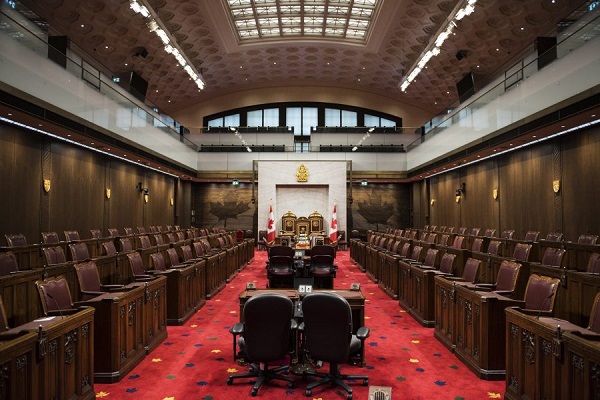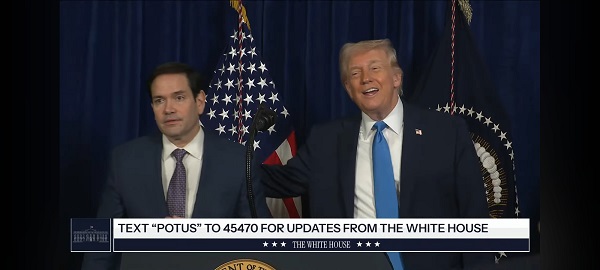Frontier Centre for Public Policy
Is the Senate in Violation of the 2006 Indian Residential Schools Settlement Agreement, and Hindering Reconciliation?

From the Frontier Centre for Public Policy
By Nina Green
Since it is abundantly clear there are no missing Indian residential school children, the ‘missing records’ by which they can be found are also imaginary, and the Senate Committee has been on a pointless wild goose chase
In July 2024 the Standing Senate Committee on Indigenous Peoples issued an Interim Report entitled ‘Missing Records, Missing Children’.
The problem with that title? There are no missing Indian residential school children.
Special Interlocutor Kimberly Murray told the Senate Committee on 21 March 2023 that there are no missing children, and in support of that one need only look to her own two interim reports, neither of which identifies a single Indian residential school child who went missing and whose parents didn’t know what happened to their child. In two years as Special Interlocutor, Kimberly Murray has not been able to name a single child who verifiably went missing from an Indian residential school.
Similarly, after two years of hearings, the Senate Committee itself was unable to name a single verifiably-missing Indian residential school child in its report.
Nor in fact has anyone in Canada to date been able to name a single verifiably-missing Indian residential school child.
Since it is abundantly clear there are no missing Indian residential school children, the ‘missing records’ by which they can be found are also imaginary, and the Senate Committee has been on a pointless wild goose chase which has cost Canadian provinces a very considerable amount of money since many of the witnesses called by the Committee have been provincial government employees whose departments have been forced to expend staff time and financial resources fruitlessly searching for records of missing Indian residential school children who are not missing.
Moreover by calling provincial coroners, medical examiners, and vital statistics department officials as witnesses, the Senate Committee has given the distinct impression that it is conducting a criminal investigation, and by focussing on Indian residential schools, the Committee has also given the distinct impression it has reconstituted itself as a new Truth and Reconciliation Commission (TRC), and is therefore in violation of the 2006 Indian Residential Schools Settlement Agreement.
What justification does the Senate Committee have for conducting this public inquiry into ‘Missing Records, Missing Children’, and threatening to compel the attendance of witnesses at its hearings?
The Committee cites the following Order of Reference passed by the full Senate as justification for its July 2024 report, and for the sweeping and far-reaching recommendations the report contains:
ORDER OF REFERENCE
Extract from the Journals of the Senate of Thursday, March 3, 2022:
The Honourable Senator Francis moved, seconded by the Honourable Senator Cordy:
That the Standing Senate Committee on Aboriginal Peoples be authorized to examine and report on the federal government’s constitutional, treaty, political and legal responsibilities to First Nations, Inuit and Métis peoples and any other subject concerning Indigenous Peoples; . . . .
It is glaringly obvious that the Order of Reference did not authorize the Committee to examine and report on missing Indian residential school children and missing records. The Senate is part of the federal government, the major party to the 2006 Indian Residential Schools Settlement Agreement under which Canadian taxpayers paid out billions of dollars to have all matters related to Indian residential schools settled once and for all – not re-opened by the Senate Committee on a whim. The Senate Committee has thus interpreted the Order of Reference as giving it an authority the full Senate did not explicitly mention, and in fact had no power to grant to the Committee.
During its proceedings over the past two years, the Senate Committee did not trouble itself to prove that there actually are missing Indian residential school children. Instead, the Committee operated on the basis that there are missing children even when Special Interlocutor Kimberly Murray told the Committee that ‘The children aren’t missing’.
Based on the false assumption that there are missing Indian residential children, the Committee proceeded to castigate those the Committee falsely claimed were ‘withholding’ records which would help to find them.
In doing so, the Committee ignored the fact that the only body which was ever actually entitled to records was the Truth and Reconciliation Commission (TRC).
Under the 2006 Indian Residential Schools Settlement Agreement, $60 million dollars was allocated to fund a Truth and Reconciliation Commission, and section 11 of the TRC’s Schedule N mandate stated that, subject to privacy interests:
Canada and the churches will provide all relevant documents in their possession or control to and for the use of the Truth and Reconciliation Commission.
It should be noted that under the TRC’s Schedule N mandate important limitations were put in place stipulating who was obligated to provide documents to the TRC, how long that obligation was to exist, and what was to be done in case of a dispute about the production of documents. The TRC’s Schedule N mandate provided that:
(1) only the federal government and the churches – i.e., not provincial governments or any other entity – were obliged to provide documents;
(2) the federal government and churches were only obliged to provide documents to the TRC during the TRC’s five-year mandate; and
(3) under section 2(l) of the TRC’s Schedule N mandate any ‘disputes over document production’ would be referred to an officially-designated body, the National Administration Committee (NAC) set up under section 4.11 of the 2006 Settlement Agreement.
The TRC concluded its work and issued a final report in 2015. That marked the end of any obligation on the part of the federal government and the churches to provide documents to the TRC, which ceased to exist and had no successor.
The Senate Committee has thus invented a problem where none existed.
That being the case – there was no problem until the Senate Committee invented one – exactly what is the problem the Senate Committee invented?
Again, one must refer back to the 2006 Settlement Agreement and the TRC’s Schedule N mandate. Section 2(a) of the Schedule N mandate states that, subject to privacy legislation, the TRC was:
authorized and required in the public interest to archive all such documents, materials, and transcripts or records of statements received, in a manner that will ensure their preservation and accessibility to the public.
To fulfil this part of its mandate, in 2013 the TRC entered into a trust deed with the University of Manitoba by which the University undertook to preserve the TRC records and make them available to the general public. That has not been done. The University of Manitoba has not made the records generated by the TRC itself in the course of its work and the records turned over to it by the federal government and the churches prior to 2015 available to the general public on its National Centre for Truth and Reconciliation (NCTR) Archives website. In particular, the University of Manitoba has not made available on its NCTR website the Sisters’ chronicles and Oblate codices which recorded daily life in the schools. Instead, the University has allowed its staff at the NCTR (which is not a legal entity and is not a successor to the TRC, but merely a building on the University of Manitoba campus staffed by University of Manitoba employees) to turn its millions of digitized records into a publicly-funded Indigenous genealogical service, as Head Archivist Raymond Frogner has explained on several occasions, and as Tanya Talaga documents in her new book, The Knowing.
Thus, if the Senate Committee had wanted to investigate an actual problem, it could have investigated why the University of Manitoba has not complied with its legal obligations under the 2013 trust deed and has not made the TRC records available to the general public as mandated by the 2006 Indian Residential Schools Settlement Agreement and the TRC’s Schedule N mandate, particularly the Sisters’ chronicles and Oblate codices which recorded daily life in the schools.
Instead of investigating that very real problem, the Senate Committee pursued a problem of its own invention by falsely claiming that records were being withheld from the ‘NCTR’ by Catholic church and provincial entities. This appears to be deliberate obfuscation because the Senate Committee must surely know that the NCTR is not a legal entity, and thus cannot legally receive documents. The actual recipient of documents sent to the ‘NCTR’ is the University of Manitoba, a fact which is never mentioned in the Senate report. Moreover the Senate report provided no evidence that any documents were actually being withheld, which of course it could not have done even had it tried since there is no legal obligation on the part of any entity to provide the University of Manitoba and the University’s NCTR staff with documents or records.
Ignoring the fact that it had invented a non-existent problem, the Senate Committee forged ahead, holding hearings and threatening to compel the attendance of witnesses. It is noteworthy that in so doing the Committee engaged in conduct which the TRC itself was forbidden to engage in under its Schedule N mandate, which states that ‘Pursuant to the Court-approved final settlement agreement and the class action judgments’, the TRC:
(b) shall not hold formal hearings, nor act as a public inquiry, nor conduct a formal legal process;
(c) shall not possess subpoena powers, and do not have powers to compel attendance or participation in any of its activities or events. Participation in all Commission events and activities is entirely voluntary;
Here is what Senator Scott Tannas had to say about holding hearings and hauling up witnesses in public on 21 March 2023 in an exchange with the University of Manitoba’s employee, Stephanie Scott:
Senator Tannas: Thank you for being here today. Ms. Scott, you mentioned that there are still organizations and people with data that has not been turned over to you. We all want to do things to help. Part of helping is listening and talking, but sometimes part of help that we can provide is to actually do something. Here in the Senate, we do have the ability to hold oversight hearings. We can compel people to come and testify before us. What would you think if you gave us the names and the contacts for organizations that aren’t providing data, and we’ll haul them up here in public and we’ll ask them why?
Ms. Scott: I would love for you to do that. We have been waiting a long time, and I think it’s absolutely crucial. When Tk’emlúps happened and the children began to speak from beyond, that’s when the world and the landscape changed for us. We used to have to do a lot of reaching out across the country, developing partnerships, still trying to acquire different records. We have worked closely — I think it’s time — the time is now, the time could be today that you call upon those people, and I would be more than willing to share that information with you. We have done a public media campaign. There are no secrets. Everything has been public and we all know what’s happened, many of us here at this table. If you are willing to do that, I respectfully would ask you to help.
Senator Tannas: I certainly would advocate for that. If you want to send the clerk, for future discussions, the name of let’s say the three most flagrant and obvious resistors, we could start maybe there and talk about it as a group. All senators would have to agree that’s a kind of meeting that we were going to have. To me, there is a time for action. As Senator Arnot mentioned, we’re not going to get anywhere until we get all the data. We won’t get to the full and complete truth, which is what all Canadians should want. It’s the only way we’re going to move forward. Thank you, that’s the only question I had.
‘Flagrant and obvious resistors’? It is unconscionable that Stephanie Scott, an employee of the University of Manitoba, would agree to provide (and did provide) the Senate Committee with a list of ‘flagrant and obvious resistors’ when she has to be aware that there is no legal obligation on the part of any entity to provide a single document to the University of Manitoba or its NCTR staff.
But even more importantly, it is unconscionable that the University of Manitoba and its NCTR employees continue to pretend that there are missing children, and continue to pretend that the University needs millions of records to identify these non-existent missing children.
Does the Senate Committee’s report further reconciliation? Obviously not. The report misleads Canadians, both Indigenous and non-Indigenous, in a way which is harmful to both by pretending that thousands of Indian residential school children are missing who are not missing, and that the provinces and the Catholic Church are withholding records that would help find them.
The Senate Committee should immediately withdraw its July 2024 interim report.
Nina Green is an independent researcher who lives in British Columbia.
Frontier Centre for Public Policy
Is Canada still worth the sacrifice for immigrants?

From the Frontier Centre for Public Policy
By Lee Harding
Immigrants are beginning to question the sacrifices they made to come to Canada, signalling deeper problems facing the country
Whenever I meet someone who immigrated to Canada from a warm place, I am always remarkably impressed. The choice to deliberately leave a pleasant, warm homeland to endure our cold winters says a lot. Overall, living in Canada is apparently better, and that should make us grateful. But what should concern us is how that upside is becoming less apparent all the time.
I recall almost a decade ago sharing a meal with Filipinos. One showed me a picture of the oceanside home he left behind where he could successfully catch fish every day without leaving home. Why would he ever leave a place like that? The answer was jobs.
It’s remarkable how Filipinos can do any job with a smile and, regardless of how little it might pay, send money to their family in their country of origin. I once told a young Filipino working at a McDonald’s to keep the change from my purchase because he was sending money back to his family. He smiled with a bit of surprise that a stranger like me would know that. He also gave me back my change, just to stay honest.
Older stock Canadians used to be like Filipinos, characterized by faith, family, hard work and gratitude. I’m afraid all four aspects have eroded in mainstream Canadian culture in recent decades, especially in the past 10 years.
At my gym two years ago, I met a Sikh named Jagjeet Singh and asked him how he liked Canada. He said when he arrived in 2019, the country was paradise on earth. Now, he said, it was turning into a s___hole. My memory fails on some of his exact observations. I only recall his disdain for the Trudeau government and the NDP leader whose name sounded a lot like his own.
While immigration to Canada remains robust, some newcomers are souring on Canada for very good reasons. This is worthy of our attention.
Maclean’s has featured several stories about immigrant struggles over the past two years, including Eleanor Zhang’s. The international student started her studies at Dalhousie University in Halifax in 2016. Back then, rent was $700 a month, people were friendly, and life was good.
By 2021, she felt things had turned for the worse. The city’s population had grown by 9.1 per cent in five years. Congested traffic left drivers angry. Her friends shared stories of their cars being broken into and items stolen. Zhang’s rent was $1,670 per month, and her grocery bills had skyrocketed. For the first time, she saw people living in the park.
Zhang wanted to start her own gift shop, but commercial spaces were so expensive that she saw little room for profit. She had fallen in love with Canada but also fell out of it. Her pursuit of a prosperous life took her back to Beijing.
Canada used to be a patriotic country with robust free speech, a respectable military, strong family and moral values, an abundance of private sector jobs and quality education and health care. Today, not so much.
Some Canadians are aware of this decline and want a new direction, while others remain aloof, ignorant and insulated from the country’s erosion. Our last election offered fresh proof of the deep generational, occupational and regional divides in Canada.
The problem is, we have to build a country together. It is hard for a people so divided against itself to stand.
Like the story of Scrooge in Charles Dickens’ A Christmas Carol, this holiday season is a good time to reflect on our past, present and future. We’re not what we were, and we could get worse, but we can also get better. As Scrooge found out, it’s not too late to turn things around and lay hold of the best Canada possible.
Lee Harding is a research fellow with the Frontier Centre for Public Policy.
Business
Ottawa Is Still Dodging The China Interference Threat

From the Frontier Centre for Public Policy
By Lee Harding
Alarming claims out of P.E.I. point to deep foreign interference, and the federal government keeps stalling. Why?
Explosive new allegations of Chinese interference in Prince Edward Island show Canada’s institutions may already be compromised and Ottawa has been slow to respond.
The revelations came out in August in a book entitled “Canada Under Siege: How PEI Became a Forward Operating Base for the Chinese Communist Party.” It was co-authored by former national director of the RCMP’s proceeds of crime program Garry Clement, who conducted an investigation with CSIS intelligence officer Michel Juneau-Katsuya.
In a press conference in Ottawa on Oct. 8, Clement referred to millions of dollars in cash transactions, suspicious land transfers and a network of corporations that resembled organized crime structures. Taken together, these details point to a vulnerability in Canada’s immigration and financial systems that appears far deeper than most Canadians have been told.
P.E.I.’s Provincial Nominee Program allows provinces to recommend immigrants for permanent residence based on local economic needs. It seems the program was exploited by wealthy applicants linked to Beijing to gain permanent residence in exchange for investments that often never materialized. It was all part of “money laundering, corruption, and elite capture at the highest levels.”
Hundreds of thousands of dollars came in crisp hundred-dollar bills on given weekends, amounting to millions over time. A monastery called Blessed Wisdom had set up a network of “corporations, land transfers, land flips, and citizens being paid under the table, cash for residences and property,” as was often done by organized crime.
Clement even called the Chinese government “the largest transnational organized crime group in the history of the world.” If true, the allegation raises an obvious question: how much of this activity has gone unnoticed or unchallenged by Canadian authorities, and why?
Dean Baxendale, CEO of the China Democracy Fund and Optimum Publishing International, published the book after five years of investigations.
“We followed the money, we followed the networks, and we followed the silence,” Baxendale said. “What we found were clear signs of elite capture, failed oversight and infiltration of Canadian institutions and political parties at the municipal, provincial and federal levels by actors aligned with the Chinese Communist Party’s United Front Work Department, the Ministry of State Security. In some cases, political donations have come from members of organized crime groups in our country and have certainly influenced political decision making over the years.”
For readers unfamiliar with them, the United Front Work Department is a Chinese Communist Party organization responsible for influence operations abroad, while the Ministry of State Security is China’s main civilian intelligence agency. Their involvement underscores the gravity of the allegations.
It is a troubling picture. Perhaps the reason Canada seems less and less like a democracy is that it has been compromised by foreign actors. And that same compromise appears to be hindering concrete actions in response.
One example Baxendale highlighted involved a PEI hotel. “We explore how a PEI hotel housed over 500 Chinese nationals, all allegedly trying to reclaim their $25,000 residency deposits, but who used a single hotel as their home address. The owner was charged by the CBSA, only to have the trial shut down by the federal government itself,” he said. The case became a key test of whether Canadian authorities were willing to pursue foreign interference through the courts.
The press conference came 476 days after Bill C-70 was passed to address foreign interference. The bill included the creation of Canada’s first foreign agent registry. Former MP Kevin Vuong rightly asked why the registry had not been authorized by cabinet. The delay raises doubts about Ottawa’s willingness to confront the problem directly.
“Why? What’s the reason for the delay?” Vuong asked.
Macdonald-Laurier Institute foreign policy director Christopher Coates called the revelations “beyond concerning” and warned, “The failures to adequately address our national security challenges threaten Canada’s relations with allies, impacting economic security and national prosperity.”
Former solicitor general of Canada and Prince Edward Island MP Wayne Easter called for a national inquiry into Beijing’s interference operations.
“There’s only one real way to get to the bottom of what is happening, and that would be a federal public inquiry,” Easter said. “We need a federal public inquiry that can subpoena witnesses, can trace bank accounts, can bring in people internationally, to get to the bottom of this issue.”
Baxendale called for “transparency, national scrutiny, and most of all for Canadians to wake up to the subtle siege under way.” This includes implementing a foreign influence transparency commissioner and a federal registry of beneficial owners.
If corruption runs as deeply as alleged, who will have the political will to properly respond? It will take more whistleblowers, changes in government and an insistent public to bring accountability. Without sustained pressure, the system that allowed these failures may also prevent their correction.
Lee Harding is a research fellow for the Frontier Centre for Public Policy.
-

 Daily Caller2 days ago
Daily Caller2 days agoTrump Says US Going To Run Venezuela After Nabbing Maduro
-

 Frontier Centre for Public Policy14 hours ago
Frontier Centre for Public Policy14 hours agoIs Canada still worth the sacrifice for immigrants?
-

 Business2 days ago
Business2 days agoVirtue-signalling devotion to reconciliation will not end well
-

 Business14 hours ago
Business14 hours agoPolicy uncertainty continues to damage Canada’s mining potential
-

 Bruce Dowbiggin14 hours ago
Bruce Dowbiggin14 hours agoThe Olympic Shutout: No Quebec Players Invited For Canada
-

 Canadian Energy Centre14 hours ago
Canadian Energy Centre14 hours agoFive reasons why 2026 could mark a turning point for major export expansions
-

 International12 hours ago
International12 hours agoNetwork of Nonprofits with Marxist and CCP Ties, and Elected Socialists Race to Counter Washington’s Narrative of the Maduro Raid
-

 Opinion2 days ago
Opinion2 days agoHell freezes over, CTV’s fabrication of fake news and our 2026 forecast is still searching for sunshine



